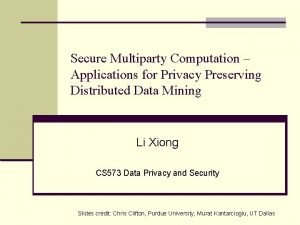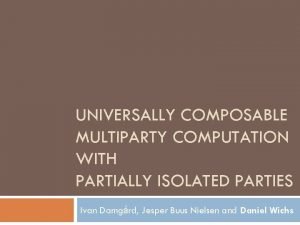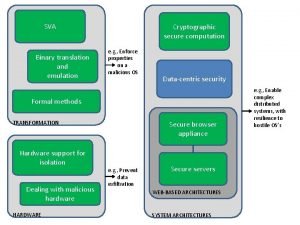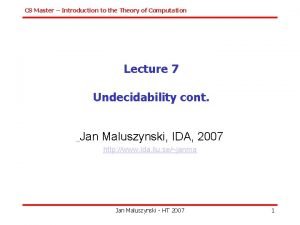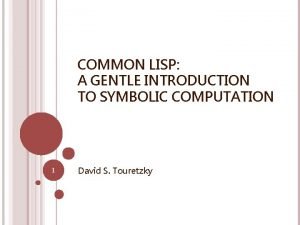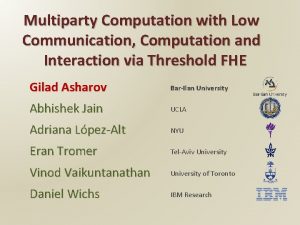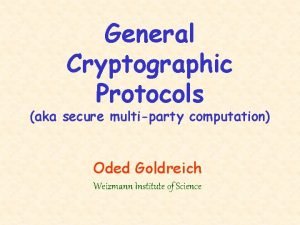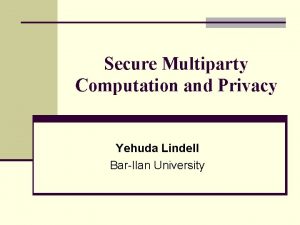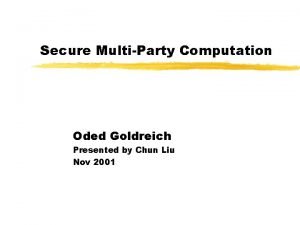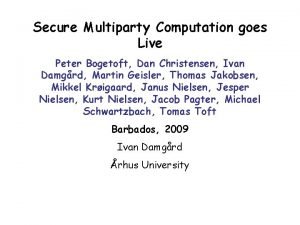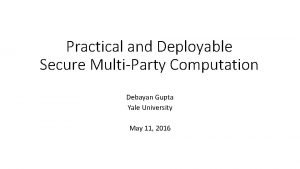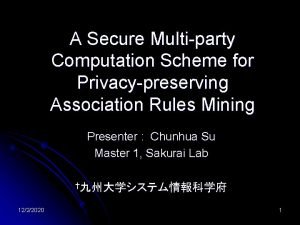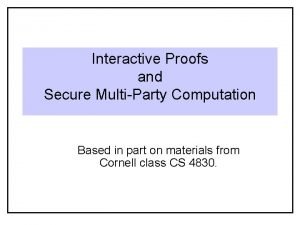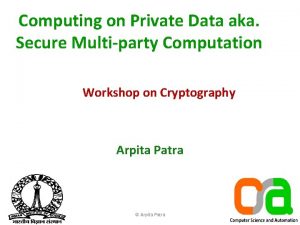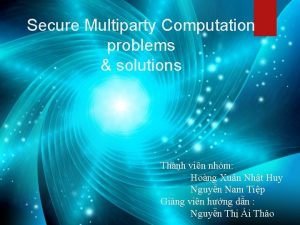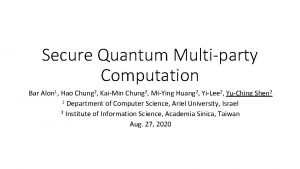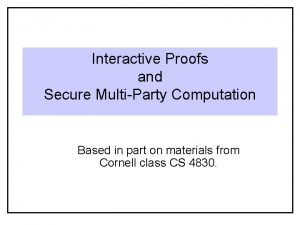CS 380 S Introduction to Secure MultiParty Computation
















![Oblivious Transfer (OT) [Rabin 1981] u. Fundamental SMC primitive A b 0, b 1 Oblivious Transfer (OT) [Rabin 1981] u. Fundamental SMC primitive A b 0, b 1](https://slidetodoc.com/presentation_image/5c2c37c7c5428d8d2125ec713bd54ec7/image-17.jpg)






- Slides: 23

CS 380 S Introduction to Secure Multi-Party Computation Vitaly Shmatikov slide 1

Motivation u. General framework for describing computation between parties who do not trust each other u. Example: elections • N parties, each one has a “Yes” or “No” vote • Goal: determine whether the majority voted “Yes”, but no voter should learn how other people voted u. Example: auctions • Each bidder makes an offer – Offer should be committing! (can’t change it later) • Goal: determine whose offer won without revealing losing offers slide 2

More Examples u. Example: distributed data mining • Two companies want to compare their datasets without revealing them – For example, compute the intersection of two lists of names u. Example: database privacy • Evaluate a query on the database without revealing the query to the database owner • Evaluate a statistical query on the database without revealing the values of individual entries • Many variations slide 3

A Couple of Observations u. In all cases, we are dealing with distributed multi -party protocols • A protocol describes how parties are supposed to exchange messages on the network u. All of these tasks can be easily computed by a trusted third party • The goal of secure multi-party computation is to achieve the same result without involving a trusted third party slide 4

How to Define Security? u. Must be mathematically rigorous u. Must capture all realistic attacks that a malicious participant may try to stage u. Should be “abstract” • Based on the desired “functionality” of the protocol, not a specific protocol • Goal: define security for an entire class of protocols slide 5

Functionality u. K mutually distrustful parties want to jointly carry out some task u. Model this task as a function f: ({0, 1}*)K K inputs (one per party); each input is a bitstring K outputs u. Assume that this functionality is computable in probabilistic polynomial time slide 6

Ideal Model u. Intuitively, we want the protocol to behave “as if” a trusted third party collected the parties’ inputs and computed the desired functionality • Computation in the ideal model is secure by definition! A x 1 x 2 f 1(x 1, x 2) f 2(x 1, x 2) B slide 7

Slightly More Formally u. A protocol is secure if it emulates an ideal setting where the parties hand their inputs to a “trusted party, ” who locally computes the desired outputs and hands them back to the parties [Goldreich-Micali-Wigderson 1987] A x 1 x 2 f 1(x 1, x 2) f 2(x 1, x 2) B slide 8

Adversary Models u. Some of protocol participants may be corrupt • If all were honest, would not need secure multi-party computation u. Semi-honest (aka passive; honest-but-curious) • Follows protocol, but tries to learn more from received messages than he would learn in the ideal model u. Malicious • Deviates from the protocol in arbitrary ways, lies about his inputs, may quit at any point u. For now, we will focus on semi-honest adversaries and two-party protocols slide 9

Correctness and Security u. How do we argue that the real protocol “emulates” the ideal protocol? u. Correctness • All honest participants should receive the correct result of evaluating function f – Because a trusted third party would compute f correctly u. Security • All corrupt participants should learn no more from the protocol than what they would learn in ideal model • What does corrupt participant learn in ideal model? – His input (obviously) and the result of evaluating f slide 10

Simulation u. Corrupt participant’s view of the protocol = record of messages sent and received • In the ideal world, view consists simply of his input and the result of evaluating f u. How to argue that real protocol does not leak more useful information than ideal-world view? u. Key idea: simulation • If real-world view (i. e. , messages received in the real protocol) can be simulated with access only to the idealworld view, then real-world protocol is secure • Simulation must be indistinguishable from real view slide 11

Technicalities u. Distance between probability distributions A and B over a common set X is ½ * sum. X(|Pr(A=x) – Pr(B=x)|) u. Probability ensemble Ai is a set of discrete probability distributions • Index i ranges over some set I u. Function f(n) is negligible if it is asymptotically smaller than the inverse of any polynomial constant c m such that |f(n)| < 1/nc n>m slide 12

Notions of Indistinguishability u. Simplest: ensembles Ai and Bi are equal u. Distribution ensembles Ai and Bi are statistically close if dist(Ai, Bi) is a negligible function of i u. Distribution ensembles Ai and Bi are computationally indistinguishable (Ai Bi) if, for any probabilistic polynomial-time algorithm D, |Pr(D(Ai)=1) - Pr(D(Bi)=1)| is a negligible function of i • No efficient algorithm can tell the difference between Ai and Bi except with a negligible probability slide 13

SMC Definition (First Attempt) u. Protocol for computing f(XA, XB) betw. A and B is secure if there exist efficient simulator algorithms SA and SB such that for all input pairs (x. A, x. B) … u. Correctness: (y. A, y. B) f(x. A, x. B) • Intuition: outputs received by honest parties are indistinguishable from the correct result of evaluating f u. Security: view. A(real protocol) SA(x. A, y. A) view. B(real protocol) SB(x. B, y. B) • Intuition: a corrupt party’s view of the protocol can be simulated from its input and output u. This definition does not work! Why? slide 14

Randomized Ideal Functionality u. Consider a coin flipping functionality f()=(b, -) where b is random bit • f() flips a coin and tells A the result; B learns nothing u. The following protocol “implements” f() 1. A chooses bit b randomly 2. A sends b to B 3. A outputs b u. It is obviously insecure (why? ) u. Yet it is correct and simulatable according to our attempted definition (why? ) slide 15

SMC Definition u. Protocol for computing f(XA, XB) betw. A and B is secure if there exist efficient simulator algorithms SA and SB such that for all input pairs (x. A, x. B) … u. Correctness: (y. A, y. B) f(x. A, x. B) u. Security: (view. A(real protocol), y. B) (SA(x. A, y. A), y. B) (view. B(real protocol), y. A) (SB(x. B, y. B), y. A) • Intuition: if a corrupt party’s view of the protocol is correlated with the honest party’s output, the simulator must be able to capture this correlation u. Does this fix the problem with coin-flipping f? slide 16
![Oblivious Transfer OT Rabin 1981 u Fundamental SMC primitive A b 0 b 1 Oblivious Transfer (OT) [Rabin 1981] u. Fundamental SMC primitive A b 0, b 1](https://slidetodoc.com/presentation_image/5c2c37c7c5428d8d2125ec713bd54ec7/image-17.jpg)
Oblivious Transfer (OT) [Rabin 1981] u. Fundamental SMC primitive A b 0, b 1 i = 0 or 1 bi B • A inputs two bits, B inputs the index of one of A’s bits • B learns his chosen bit, A learns nothing – A does not learn which bit B has chosen; B does not learn the value of the bit that he did not choose • Generalizes to bitstrings, M instead of 2, etc. slide 17

One-Way Trapdoor Functions u. Intuition: one-way functions are easy to compute, but hard to invert (skip formal definition for now) • We will be interested in one-way permutations u. Intution: one-way trapdoor functions are one-way functions that are easy to invert given some extra information called the trapdoor • Example: if n=pq where p and q are large primes and e is relatively prime to (n), fe, n(m) = me mod n is easy to compute, but it is believed to be hard to invert • Given the trapdoor d s. t. de=1 mod (n), fe, n(m) is easy to invert because fe, n(m)d = (me)d = m mod n slide 18

Hard-Core Predicates u. Let f: S S be a one-way function on some set S u. B: S {0, 1} is a hard-core predicate for f if • B(x) is easy to compute given x S • If an algorithm, given only f(x), computes B(x) correctly with prob > ½+ , it can be used to invert f(x) easily – Consequence: B(x) is hard to compute given only f(x) • Intuition: there is a bit of information about x s. t. learning this bit from f(x) is as hard as inverting f u. Goldreich-Levin theorem • B(x, r)=r x is a hard-core predicate for g(x, r) = (f(x), r) – f(x) is any one-way function, r x=(r 1 x 1) … (rnxn) slide 19

Oblivious Transfer Protocol u. Assume the existence of some family of one-way trapdoor permutations Chooses a one-way permutation F and corresponding trapdoor T Chooses his input i (0 or 1) F A Chooses random r 0, 1, x, ynot i Computes yi = F(x) r 0 , r 1 , y 0 , y 1 b 0 (r 0 T(y 0)), b 1 (r 1 T(y 1)) B Computes mi (ri x) = (bi (ri T(yi))) (ri x) = (bi (ri T(F(x)))) (ri x) = bi slide 20

Proof of Security for B F A Chooses random r 0, 1, x, ynot i Computes yi = F(x) r 0 , r 1 , y 0 , y 1 b 0 (r 0 T(y 0)), b 1 (r 1 T(y 1)) B Computes mi (ri x) y 0 and y 1 are uniformly random regardless of A’s choice of permutation F (why? ). Therefore, A’s view is independent of B’s input i. slide 21

Proof of Security for A (Sketch) u. Need to build a simulator whose output is indistinguishable from B’s view of the protocol Knows i and bi (why? ) Chooses random F, random r 0, 1, x, ynot i computes yi = F(x), sets mi=bi (ri T(yi)), random mnot i Sim F Random r 0, 1, x, ynot i yi = F(x) r 0 , r 1 , y 0 , y 1 b 0 (r 0 T(y 0)), b 1 (r 1 T(y 1)) B The only difference between simulation and real protocol: In simulation, mnot i is random (why? ) In real protocol, mnot i=bnot i (rnot i T(ynot i)) slide 22

Proof of Security for A (Cont’d) u. Why is it computationally infeasible to distinguish random m and m’=b (r T(y))? • b is some bit, r and y are random, T is the trapdoor of a one-way trapdoor permutation u(r x) is a hard-core bit for g(x, r)=(F(x), r) • This means that (r x) is hard to compute given F(x) u. If B can distinguish m and m’=b (r x’) given only y=F(x’), we obtain a contradiction with the fact that (r x’) is a hard-core bit • Proof omitted slide 23
 Compute
Compute Multiparty computation
Multiparty computation Two round multiparty computation via multi-key fhe
Two round multiparty computation via multi-key fhe Binary search in secure computation
Binary search in secure computation Sipser, m: introduction to the theory of computation
Sipser, m: introduction to the theory of computation Introduction to the theory of computation
Introduction to the theory of computation Common lisp a gentle introduction to symbolic computation
Common lisp a gentle introduction to symbolic computation Ssis 380
Ssis 380 Ee 380
Ee 380 690-380
690-380 454 hangi yüzlüğe yuvarlanır
454 hangi yüzlüğe yuvarlanır Zodiac cadet fastroller
Zodiac cadet fastroller 380 gelir tahakkukları
380 gelir tahakkukları Romsat.ua
Romsat.ua Nyogel 774vh
Nyogel 774vh Dönem ayırıcı hesaplar örnek
Dönem ayırıcı hesaplar örnek Ee 380
Ee 380 Cit594
Cit594 Dönem ayirici hesaplar 180 181 280 281 380 381
Dönem ayirici hesaplar 180 181 280 281 380 381 380 lexington ave
380 lexington ave 507-802-380
507-802-380 Diagrama dispersão
Diagrama dispersão Town b is 380 km due south of town a
Town b is 380 km due south of town a Kevin 380
Kevin 380
